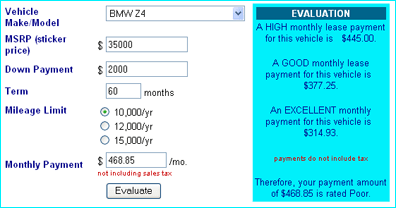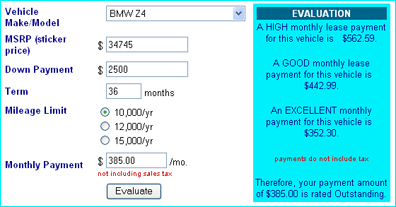Monthly Payments – Not Best Way to Negotiate a Car Lease
Many automotive consumers who decide to lease do so only because the payments are more affordable than purchase loan payments. In fact, dealers often encourage the comparison of leasing versus buying on this basis. But it doesn’t necessarily mean leasing is a better deal.
However, getting a great car lease deal is more than comparing lease payments and loan payments.
What’s a payment buyer?
Automobile buyers and leasers who fall into this potential trap are known as “payment buyers” and dealers love them. They are only interested in monthly payment amounts, without regard to selling price, interest rate, trade-in value, residual values, or any other factors that determine overall cost.
What’s the problem with negotiating monthly payments when leasing?
Unless you do your homework beforehand, any monthly payment amount that a dealer may offer you will be impossible to evaluate in any real sense. You won’t know if it’s a good deal or not. You’ll only know how one payment figure compares to others that you’ve been offered. It’s possible that all your offers are bad deals, even the lowest offer.
More knowledgeable customers who visit the same dealer will almost always pay less than you. The dealer will take advantage of your lack of knowledge and convince you to pay more than you should — and then congratulate you for getting such a great deal.
Leasing is particularly problematic for payment buyers because there are a larger number of factors that make up a lease payment than for a loan payment.
It’s nearly impossible to judge the real value of a car lease deal when payment amount is the only factor you have to work with.
Let’s look at an example
Let’s assume you’re shopping for a new BMW Z4 sports car and have a $500/month payment budget, and can make a $2000 down payment. Let’s say you prefer to buy, not lease.
You visit your local BMW dealer and find just the car you want with a sticker price of $35,000. The salesperson quotes you a monthly payment of $637.98 to purchase the car with a loan, with $2000 down payment.
What he might not have mentioned is that the loan payment is based on full sticker price, 6.0% interest, and 60 months. You see that the payment is too high for your budget and ask for a better deal. After some time, the salesperson comes back with a $592.14 payment, based on a slightly discounted price and a lower interest rate on the loan. This might actually be a good deal, but still too much for your budget, so you won’t consider it.
Now, the salesperson sees that he’s not going to be able work a loan deal so he suggests a lease — and offers a $468.85 payment, for 60 months, just like the loan, with the same $2000 down payment. Now we’re talking. You’re feeling good because you’ve just “talked him down” (negotiated) to a “much better deal” than the original offer and you’ve considerably under your budget goals. The salesperson assures you that this is as good as it gets. What a sweet deal (you think).
But wait. Is the dealer actually giving you a better deal?
Let’s look at this lease deal more closely with our Lease Evaluator, which is part of our Lease Kit. We’ll plug in the numbers, including the payment amount that you’ve been offered, and click the “Evaluate” button. Here’s our result.

BMW Lease Evaluation
What’s wrong with this deal?
Notice that this deal is rated “POOR” by our Lease Evaluator. This is much too much to pay for a lease for this car. It’s not a good deal at all even though the payment meets your budget and is much less than loan payments for the same car.
The dealer didn’t give you much information — only a monthly payment amount of $468.85 and some other basics, such as the number of months in the lease (60 months) and the mileage (10,000 miles per year). He didn’t give you all the information that would allow you to know this is a good deal or not.
What the dealer didn’t tell
What he didn’t tell you is that when he calculated this lease, he used $37,000 as the selling price ($2000 over full sticker price) and added a “bump” of 0.5% to the interest rate. Furthermore the residual percentage he used was 45%, which is not a great residual for a 60 month, 10K miles, lease on a BMW Z4. You could verify his payment amount with our Lease Calculator (if he gives you all his figures) but you still wouldn’t know if that figure represents a good deal or not. All you would know is that he did his math correctly, using his inflated figures.
But the Lease Evaluator caught this bad deal before you made a serious mistake. Lucky you.
Of course, if you accepted this deal you would also be accepting the fact that the lease is for 60 months, which is a year longer than the Z4’s bumper-to-bumper warranty (48 months), and that the mileage limit is 10K miles per year, which may be fewer miles than you normally drive. 60 month leases are almost never a good idea, and actually almost never offered.
So, even though it seemed you were getting a great deal based on a comparison of loan payment versus lease payment, you were actually getting a terrible lease deal.
Other customers who were more informed than you were getting better deals for the same car, from the same dealer, on the same day.
What’s a better deal?
After wisely declining the dealer’s lease offer, you notice a BMW lease ad in your weekend newspaper from another dealer that shows the same Z4 for only $385 per month, 36 months, 10,000 miles per year, $2500 down payment. The MSRP is slightly less at $34,745.
At $385, the monthly payment is certainly better than your last offer, although the terms are a little different (36 months, 10K miles/year, $2500 down payment). This is a 36 month lease as compared to 60 months in the previous deal, allowing you to stay within your warranty period for the entire lease term. The mileage limit is the same, but you’ll need $500 more for your down payment.
As attractive as this might appear (because the payment is lower), is this really a better deal? There are a number of factors that are different from the original deal, which makes the two deals difficult to compare. We have no way to judge the new deal without a little help.
Let’s put our Lease Evaluator to work again. We’ll plug in the numbers from the dealer ad and see how it looks.

WOW! Look at these evaluation results. This is a much better deal. In fact, it’s a great deal. The Lease Evaluator rates it as “Outstanding.”
Notice that the advertised payment of $385 is only slightly higher than the best rated payment amount, $352, for this vehicle. This is obviously a deal that has been subvented by BMW Financial Services to help move their cars during this promotion. Although all the details are not disclosed in car lease ads, we can deduce that this deal is based on a heavily discounted price, along with an attractive money factor (interest rate), and a nice high residual value. This is the kind of deal that you would not be able to negotiate on your own. It can only come from the manufacturer as a promotional deal. The dealer could not offer such a deal without his manufacturer’s help.
Don’t be a payment buyer when you lease
From our examples, it should be clear that buying and leasing cars shouldn’t be based on payment amount alone. The reason is that you have no easy way to determine whether you’re getting a good deal — or being taken to the cleaners.
Our Lease Kit provides two useful tools for evaluating leases. One is the Lease Evaluator that we’ve already mentioned, which should be used before you lease to evaluate deals that you’re offered by dealers, or deals you see advertised in newspapers or on TV. These are deals that offer a monthly payment amount without much other detail.
The other tool, the Lease Inspector, is typically used after you lease, when you have a lease contract, and have all the details of your lease. Using the exact figures right from your contract, you’ll be told how good — or bad — your deal was. It even checks the dealer’s math to make sure your payment amount was correctly calculated.
Do your homework
If you do your homework before you visit a dealer to lease a car, you will have already done some calculations (using our calculators of course) to determine approximate monthly payments for the car you want. You can make assumptions about price discounts (see Dealer Profit Margins in our Lease Kit), residual values (see Residual Value Calculator in our Lease Kit), and money factors (check new-car interest rates at Bankrate.com, then divide by 2400 to get lease money factor).
